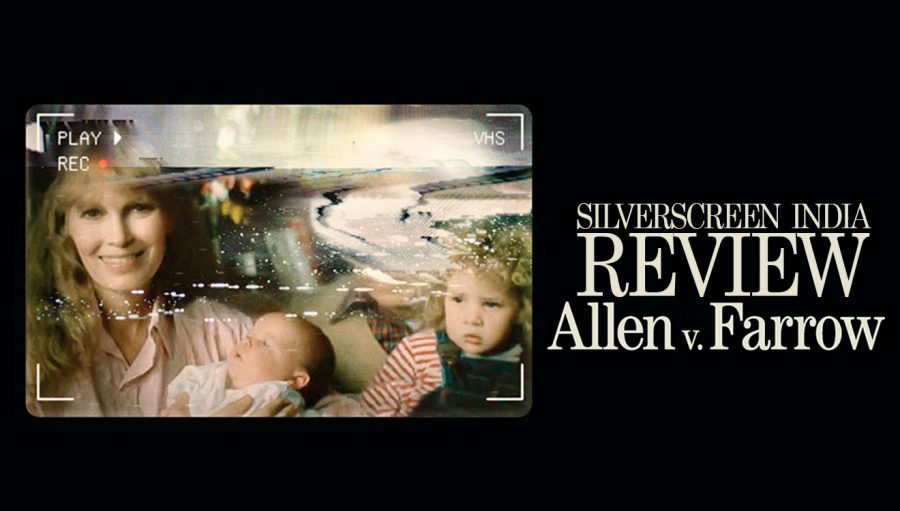A lot of people would say they’re familiar with the Woody Allen – Mia Farrow story. But as Dylan Farrow, the couple’s adopted daughter who accused Allen of sexually assaulting her when she was a seven-year-old says in Allen v Farrow, HBO’s new hard-hitting four-part docu-series, “No matter what you think you know, it’s just the tip of the iceberg.”
Mia Farrow and Allen met at Elaine’s, a Manhattan restaurant, in 1979 when Michael Caine introduced them to each other. Allen, at the time, was basking in the success of Annie Hall and Academy award wins for Best Director, Best Original Screenplay that year and Mia Farrow, daughter of director John Farrow and actor Maureen O’Sullivan, after doing several acclaimed films such as Rosemary’s Baby, The Great Gatsby and finding fame through TV series Peyton Place, was on a Broadway play with Anthony Perkins. They quickly became one of New York’s power couples.
When they started dating, Mia Farrow was divorced and had seven children- three biological children Matthew, Sascha and Fletcher with ex-husband and composer Andre Previn, and two daughters Lark Song and Daisy that the couple adopted later. In 1978, Mia Farrow and Previn adopted Soon-Yi from South Korea. She is believed to have been seven-year-old at the time. After her divorce from Previn, Mia Farrow adopted Moses from South Korea in 1980.
“He very much was a father figure. I mean I had my actual father, but he was not around day-to-day and Woody very much functioned in that capacity. He would have meals with us, we’d fish in the pond together up in Connecticut,” says Fletcher Previn in the documentary.
The documentary uses home video footages, court documents, audio tapes and exclusive interviews with investigators and prosecutors who worked on the case, including Frank Maco, the attorney who finally decided not to press charges against Allen in the sexual assault case. Allen and his wife Soon-Yi, the documentary notes, did not respond to requests for an interview. The documentary series instead uses a few audio excerpts from Allen’s 2020 memoir Apropos of Nothing.
“I would get up in the morning and he (Woody) would be there, waiting for the kids to wake up. We would go to his house on the weekends, spend the night when my mum would spend the weekend with him. In the back of his apartment, he made bunkbeds and stuff so we’d feel comfortable going there while my mum was there,” Daisy Previn says.
Allen, however, denies being a father figure to the kids. In an interview excerpt sampled in the documentary he says; “Mia and I, we don’t live together. She is surrounded by kids and I live by myself across the park. And we see each other quite frequently but I’m still as I was. I mean, I do I play with the kids all the time but then I never have to be there when the diapers are changed or when something really awful happens.”
A few years into their relationship, Mia Farrow asked Allen if he would like to have a child together and Allen said he wasn’t opposed to the idea but that Mia Farrow would be solely responsible for the child, financially as well.
“After some years of trying to have a baby and not conceiving a child, I asked how he would feel about adopting a child. He said if I wanted to do that, it wouldn’t ruin the relationship but he wanted nothing to do with it. And I thought: that’s fair He knew the kind of children that I adopted, they were all from different countries with different needs. And he said ‘Well, I would be more kindly disposed if it was a little blond girl,” Mia Farrow says in the docu-series.
This led to the couple adopting Dylan from Texas in 1985, when she was six-weeks-old.
Allen’s fondness towards Dylan Farrow quickly grew into an obsession, say family friends, with him often forcing her to spend time with him alone and taking her away from siblings and her mother.
In 2014, in a bombshell open letter in the New York Times that Dylan Farrow authored shortly after that year the Golden Globes awarded Allen with the Cecil B DeMille lifetime achievement award and a glowing tribute from actors such as Diane Keaton and Emma Stone, she wrote that her father had been doing things to her that she didn’t like for as long as she could remember.
“I didn’t like how often he would take me away from my mom, siblings and friends to be alone with him. I didn’t like it when he would stick his thumb in my mouth. I didn’t like it when I had to get in bed with him under the sheets when he was in his underwear. I didn’t like it when he would place his head in my naked lap and breathe in and breathe out. I would hide under beds or lock myself in the bathroom to avoid these encounters, but he always found me,” she wrote.
In December 1987, Mia Farrow gave birth to Satchel Ronan O’Sullivan Farrow, now known as Ronan Farrow. In a 2013 interview with Vanity Fair, Farrow suggested that her ex-husband Frank Sinatra may actually be Ronan’s father. Allen legally adopted Moses and Dylan Farrow in 1991.
In January 1992, Mia Farrow found naked pictures of 21-year-old Soon-Yi in Allen’s apartment, which she described to be of “pornographic” nature. Allen was 57 at the time.
“They wouldn’t put them in Playboy. They were like, I don’t know, Hustler pictures or something,” Mia Farrow says in the documentary.
In an interview with Walter Isaacson of Time magazine in 2001, Allen says: “Soon-Yi had talked about being a model and said to me would I take some pictures of her without her clothes on. At this time we had an intimate relationship, so I said sure, and I did. It was just a lark of a moment. The heart wants what it wants.” He added that he faced no “moral dilemma whatsoever”. “It wasn’t like she was my daughter.”
Allen and Soon-Yi got married in 1997. Allen was 62 at the time, while she was 27.
When Allen and Soon-Yi began dating, she was a teenager and, in the documentary, Mia Farrow says she spoke to the doormen and cleaning ladies at Allen’s apartment who confirmed that there were condoms in the dust bins and what looked like semen stains on the sheets after Soon-Yi’s visits. Allen’s housekeeper testified to this in court.
Allen however maintains his relationship with Soon-Yi began only after her first semester of college. Mia Farrow says soon after she found out about Allen and Soon-Yi’s relationship, Soon-Yi returned to college and one day disappeared from summer camp. She was last seen getting into a limousine. Allen, in the Apropos Of Nothing audio excerpt says she went to New York from camp and stayed with a “friend”.
On August 4, 1992, on a day Mia Farrow was out shopping and the kids were left in the care of two babysitters, Allen came to visit. The next day, one of the babysitters told her that she had walked in on Allen in the TV room, with his face on Dylan Farrow’s lap. Soon after this, Mia Farrow asked Dylan Farrow what happened that day as the babysitters said they couldn’t locate Allen or Dylan Farrow for 20 minutes. That was when Dylan Farrow told Mia Farrow about the abuse.
The documentary includes the home videos that Mia Farrow shot, in which Dylan Farrow says Allen took her to the attic in their Connecticut home and touched her “private parts”.
“I didn’t want him to do it, Mama. I don’t like it, and I also don’t want to talk about it” seven-year-old Dylan Farrow tells Mia Farrow in a heartbreaking video.
Later, a a 32-year-old Dylan Farrow told Gayle King on CBS This Morning, “He touched my labia and my vulva with his finger.” In her 2014 open letter, she wrote: “He told me to lay on my stomach and play with my brother’s electric train set. Then he sexually assaulted me. He talked to me while he did it, whispering that I was a good girl, that this was our secret, promising that we’d go to Paris and I’d be a star in his movies.”
On August 13, 1992, nine days after the alleged sexual assault, Allen sued Mia Farrow for custody of Dylan Farrow, Ronan and Moses- a case he would eventually lose along with visitation rights to see Dylan Farrow and unsupervised visitation rights to see Moses and Ronan. The judge had said Allen was “self-absorbed, untrustworthy and insensitive”. Four days later, Allen gave a public statement saying he was in a relationship with Mia Farrow’s daughter Soon-Yi and later denied allegations of sexually assaulting seven-year-old Dylan Farrow, a stand he maintains to this day.
Allen painted a picture of Farrow as the scorned, “hysterical” woman who would go to great lengths to harm his reputation, says the documentary. He said Mia Farrow had “coached” Dylan Farrow, which was also mentioned in a Yale–New Haven Hospital report, to say he had sexually assaulted her because she had discovered his relationship with Soon-Yi. The Yale-New Haven report was later deemed to be flawed.
In 1993, state attorney Franc Maco, who appears in the documentary in conversation with Dylan Farrow, decided not to press charges against Allen based on the investigation carried out by Connecticut State Police even though there was “probable cause”. This was to spare her the additional “trauma”, Maco tells Dylan Farrow in the fourth episode of the docu-series.
At the end of each episode, we are reminded that Allen has never been charged with the crime and to this day, continues to deny the allegations of sexual assault. In fact, in 2018, Allen said that he must be the “poster boy for the #MeToo movement”.
Even after Dylan Farrow spoke out about the abuse as an adult, established actors continued to sign his films and many have even spoken in support of the filmmaker, including Keaton and Alec Baldwin.
With his neurosis, iconic khakhi shorts and consistent stutter, Allen was not only a critically and commercially successful filmmaker but an American cultural phenomenon. His ability to transform a seemingly simple storyline and turn it into a rib-tickling feature film found him a doting fanbase in other parts of the world as well, a fact he has used to his advantage recently by releasing films outside the US. His 2019 film, A Rainy Day In New York (Timothee Chalamet, Selena Gomez) that lay around undistributed in the US grossed more than $22,000,000 internationally.
The fourth episode of the docu-series in fact explores this conundrum- how to consume art. In a post #MeToo world, can art be separated from the artist? As Ronan says in the documentary, there was a huge difference in the way the world reacted to Dylan Farrow’s allegations against Allen in 2014, and then later in 2018. What happened in this window?
“The culture changed in that window in a significant way,” says Ronan, author of the New Yorker piece in which 13 of Harvey Weinstein’s accusers tell their story.
Allen v. Farrow is slanted, there’s no doubt about that. But it is unapologetically slanted. It uses the four, hour-long episodes to paint a horrific picture of how the justice system failed to protect a seven-year-old survivor of sexual abuse, how a powerful child abuser used his wealth, his fame and his PR team to create a false narrative and perhaps what was most difficult to watch, how the world continued to celebrate an abuser.
Recommended
Sure, Allen’s films were at one time considered path-breaking and everyone has a favourite Woody Allen film. But in Dylan Farrow’s words: “So imagine your seven-year-old daughter being led into an attic by Woody Allen. Imagine she spends a lifetime stricken with nausea at the mention of his name. Imagine a world that celebrates her tormenter. Are you imagining that? Now, what’s your favorite Woody Allen movie?”
****
The Allen v. Farrow review is a Silverscreen original article. It was not paid for or commissioned by anyone associated with the film. Silverscreenindia.com and its writers do not have any commercial relationship with movies that are reviewed on the site.



